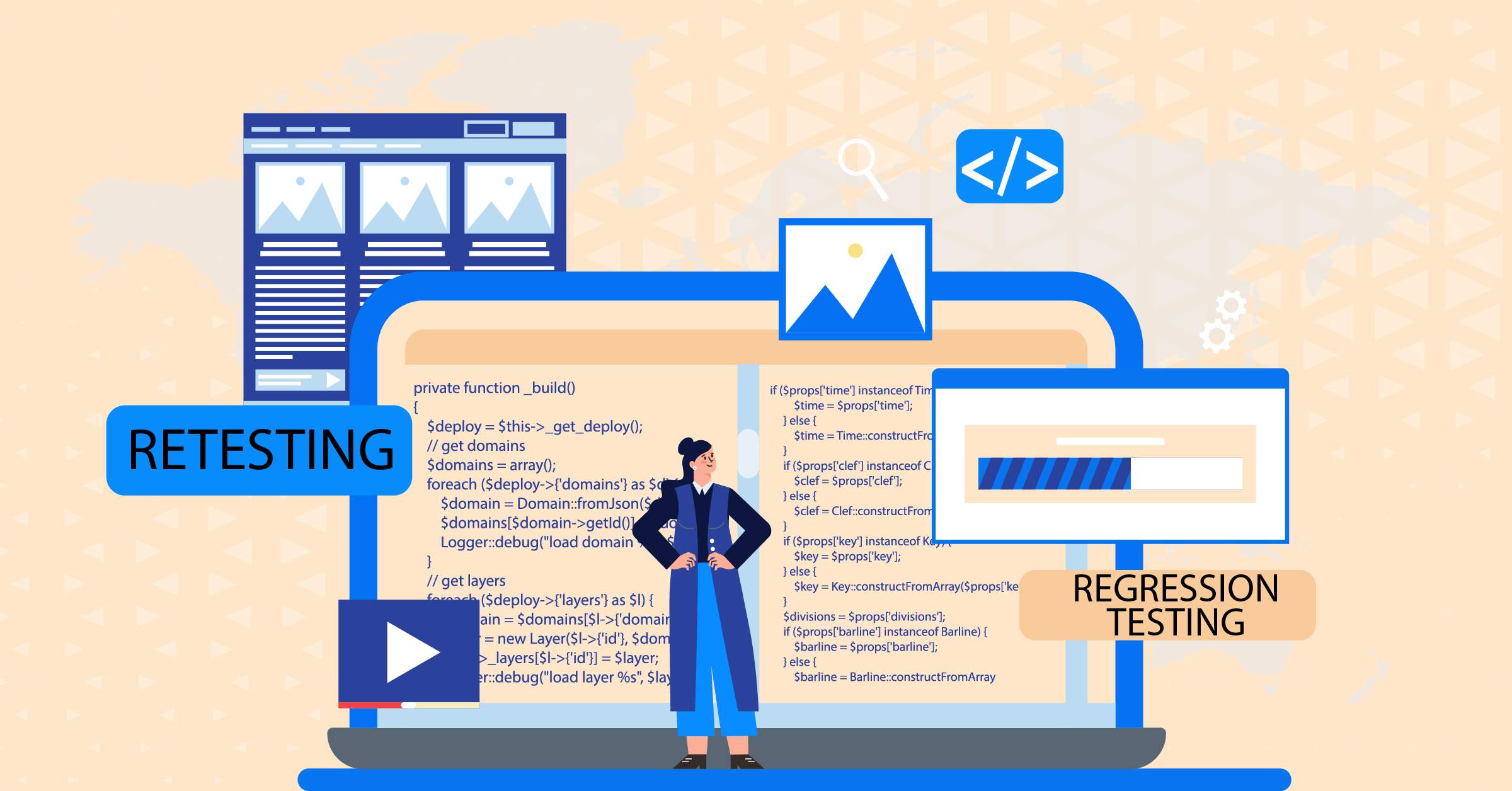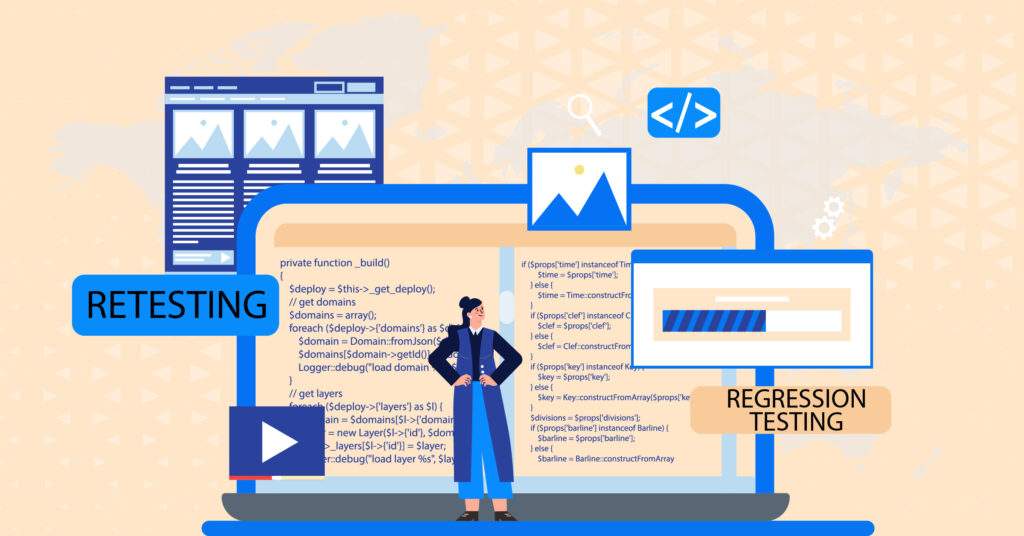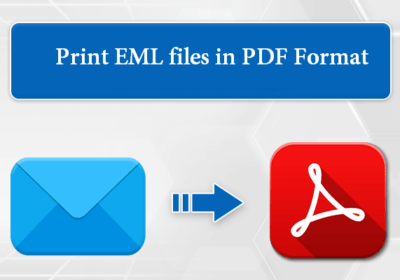
Retesting and Regression Testing: The Ultimate Guide
Software development is concerned with ensuring that programs work properly. However, as software changes, problems frequently spring up that impact performance. As a result, there are two important techniques to overcome these challenges—retesting and regression testing.
Retesting means verifying that previously discovered issues in the software have been fixed. Regression testing uses a more inclusive methodology. It includes evaluating the complete piece of software to find brand-new problems resulting from recent adjustments.
Due to today’s quick technology breakthroughs, the significance of these strategies has increased. They defend against the emergence of old problems as well as the introduction of new ones. As a result, artificial intelligence and automation could have a bigger impact, simplifying testing and more effectively locating problems as a consequence.
Thus, this makes it necessary for you to be updated with retesting and regression testing. Moreover, if required, you can get in touch with regression testing service providers at Appsierra.
So, without wasting any further time, let us discover the insights!
What are retesting and regression testing?
Regression testing and retesting are essential techniques in the software industry. They guarantee dependable and consistent program performance. Retesting verifies that fixes are still working and problems aren’t resurfacing. Also, retesting avoids lingering flaws that might negatively affect user experience while evaluating and rechecking previously corrected issues.
On the other hand, the importance of regression testing is comparable. It prevents potential new unexpected problems brought on by software upgrades or fixes. In order to identify any unintended consequences brought on by modifications, the entire system is extensively examined. So this stops the creation of new issues that can jeopardize the performance of the software.
Moving forward let us discover the differences between the two.
How do retesting and regression testing differ?
In the process of quality assurance, retesting, and regression testing fulfill several functions. But, they do have some differences as well. So let us take a glance at their differences:
| Aspect | Retesting | Regression testing |
| Definition | Retesting involves checking that a fixed issue is really fixed. | Regression testing is about testing a lot after changes. |
| Process | Testers rerun the same tests that found the problem. | Many different tests are done to see how changes affect things. |
| Focus | It’s all about making sure that one specific thing works. | It looks at how changes affect the whole software. |
| Goal | To be sure the problem doesn’t come back. | To catch new problems caused by changes. |
| Functionality Check | It checks if the particular thing that was broken works now. | Regression testing in software testing stops new changes from breaking what used to work. |
| System stability checks | It involves stability checks rarely to ensure no new consequences of the changes. | It makes sure the whole software doesn’t become unstable. |
Now that we have gone through the differences between retesting and regression testing, let us see how to implement them.
How to implement retesting and regression testing?
Implementing retesting and regression testing effectively requires a structured approach. So here’s how to implement it:
- Retesting implementation
- Identify defects – Make sure the software’s flaws or problems are adequately documented after finding them. That, too, with thorough explanations of how they were discovered and also what caused them.
- Fix defects – Now focus on correcting the found flaws. This updates and modifies the code as needed.
- Develop test cases – Make particular test cases based on the flaws. The flaws mimic the scenarios where the issues were initially found
- Execute retesting – Execute the developed test cases. It checks to see if the identified flaws have been effectively fixed. So compare the actual outcomes with the anticipated results.
- Regression testing implementation
- Build a test suite – Create a thorough set of test scenarios. Ones that cover a range of the software’s features and functions.
- Automate – Consider employing testing frameworks to automate the process to handle the significant amount of test cases. This promotes consistency in execution and also saves time.
- Version control – Keep adequate version control on your regression testing in software testing and software resources. As a result, this keeps precise track of changes.
- Baseline testing – Perform baseline testing before implementing any upgrades or modifications. The complete test suite on the latest software version is run to achieve this. So this creates a standard for comparisons in the future.
- Execute regression suite – Run all of the software’s regression tests on the new version. This suite needs to offer a variety of features. It guarantees that recent adjustments haven’t brought any unexpected issues or disputes.
- Analyze results – Compare regression test findings to baseline values. Moreover, find any inconsistencies, errors, or unusual behaviors. A regression testing service provider can implement all these steps for you as well.
We also have some practices that one can maintain to multiply results during the implementation of visual regression testing. So what are these? We will take a look at that in the section ahead.
What are the best practices?
Some fundamental testing techniques can considerably increase the efficacy of these essential software testing techniques.
- First and foremost, it’s crucial to keep accurate and thorough records of the problems and remedies. This aids in precisely repeating tests and validating that fixes have been successful. However, a regression testing service provider ensures a thorough record is kept and your software is continuously improved.
- Second, wherever you can, automate your testing. Automation technologies make testing more efficient and less prone to human mistakes. Speeding up testing cycles simplifies both regression testing and retesting. This is also particularly true when changes occur often.
- Another sensible strategy is to update and increase your test cases often. Changes and new features may have an impact on many program components. Therefore, having a diverse range of test cases assures thorough coverage and more precise findings.
Setting test case priorities is crucial, especially when performing regression testing. Not every functionality is equally important. Focus on high-priority test cases to quickly identify critical issues. So this stops time from being wasted on software that isn’t as important.
Using version control procedures makes maintaining a precise history of software modifications and testing assets possible. Moreover, visual regression testing notably benefits from this. It is to comprehend what changed between versions and also the potential causes of certain problems.
Retesting and regression testing should also be incorporated into your software development process. Starting with it is highly recommended. Regular testing iterations, ideally following each code change, help prevent the buildup of unresolved problems. It also makes it simpler to identify the root of any issues.
Conclusion
Retesting and regression testing act as crucial quality checkpoints in the dynamic software landscape. While regression testing safeguards against unexpected issues, retesting confirms fixes. Adhering to these best practices ensures both stable software and reliable user experiences. These testing methods are imperative to sustain the functionality and user contentment of our digital tools.

















